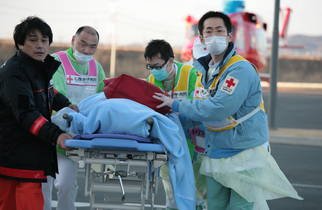Medical Services
Medical services lay at the very core the Red Cross' mission to protect human life, health and dignity. In order to live up to this mission, the JRCS medical services division provides medical care of the highest quality to patients throughout the country and beyond.
Major Features

The JRCS is prepared at all times to implement prompt medical relief activities in the event of a disaster. As a stand-by arrangement, Red Cross hospitals register their doctors and nurses as relief personnel. Mobilizing these resources from Red Cross hospitals around the country at a moment's notice is part of the JRCS' emergency response. Additionally, 68 Red Cross hospitals are designated as "Disaster Relief Core Hospitals." This means that they are outfitted with the equipment and facilities necessary to ensure the provision of medical services should a disaster occur in their respective regions.

There are 88 Red Cross hospitals that are designated as "Emergency Hospitals," meaning they are equipped to accept emergency patients. 26 hospitals are designated "Medical Emergency and Critical Care Centres." These are ready to receive seriously ill or injured emergency patients around the clock. Furthermore, 6 hospitals are designated as "Advanced Medical Emergency and Critical Care Centres," and are able to provide advanced medical care of the highest level.
Some hospitals are equipped with specialized, advanced medical treatment, diagnostic facilities, and wards for cancer and circulatory disease patients. Others undertake kidney transplants, bone marrow transplants, and HIV/AIDS treatment. The amenities at each of these hospitals vary depending on their respective expertise and local geographic contexts.
17 JRCS hospitals located throughout the nation are designated as "Remote Area Medical Care Bases." These facilities operate mobile clinics that visit mountain villages, secluded areas, and remote islands where medical care is often under-resourced. These clinics conduct physical examinations and work to prevent diseases.
11 JRCS hospitals are designated as "Comprehensive Maternal and Perinatal Care Centres," offering a range of advanced, specialized and integrated medical care covering everything from pregnancies and deliveries, to treatment and care of newborns. These hospitals can cope with every kind of pregnancy and delivery abnormalities and are on 24-hour standby, ready to protect the lives and health of any mother and child.

In response to Japan's aging society, the JRCS provides beds for long-term care patients, as well as nursing and rehabilitation facilities for the elderly. It also manages visiting nursing stations and comprehensive regional support centres in order to assist in home-care and treatment.
The Nuclear Radiation Effects Countermeasure Research Institute - the world's only facility dedicated to research on the aftereffects of exposure to nuclear radiation - is established as a part of the JRCS Atomic-bomb Survivors Hospitals in Hiroshima and Nagasaki. The facility plays a major role in the treatment of atomic bomb survivors.
As a member of the International Red Cross and Red Crescent Movement, the JRCS is also engaged in medical relief operations abroad in times of emergency. As such, 5 of its hospitals are designated as "International Medical Relief Core Hospitals." The JRCS also accepts foreign health-care professionals for training.
History
Charged with the mission of training relief personnel, including registered nurses, the Japanese Red Cross Society's first medical facility opened in 1886. Under the Medical Care Act of 1951, JRCS hospitals were designated as "Public Medical Institutions." They began assuming responsibilities as a part of the health policies - provision of medical care in disaster-stricken areas, remote areas, and in the event of an emergency - implemented by the national government.
Since the JRCS' mission relates to public service, its medical services are entitled to a partial tax exemption. Financially, each facility is operated independently.




